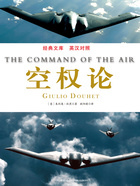
PREFACE
THE FIRST EDITION of The Command of The Air was published in 1921 under the auspices of the Ministry of War. In the years since then many of the ideas incorporated in the present edition have been put into effect. In fact, the cardinal points of the program for national defense which I proposed have been accepted and incorporated into the organization of the armed forces of the nation; namely:
1. Co-ordination of army, navy, and air force under a unified command, a concept I propounded in the 1922 issue of National Defense.
2. The constitution of a Council, then of a Ministry, of Aeronautics.
3. A distinction between an Independent Air force and auxiliary aviation, thereby putting into effect a concept which I held to be of vital importance to national defense and in correspondence with the facts of the present situation.
It may seem that if my ideas have been accepted and put into practice, there is no need for a second edition of my book. But I think there is a need for it, and here are my reasons for reprinting what I wrote then and adding to it a second part:
When I wrote the first version in 1921, more than ten years had passed since I first voiced the ideas expressed there. During all those years I had been trying with all my might to drive home the realization of the importance of air power, but all my efforts met defeat at the hands of military authorities and government bureaucracies. Finally, in 1921, owing to a change in circumstances which need not be mentioned here, I succeeded in getting it published by the Ministry of War and distributed among the personnel of the army and navy. This was the first success won by my long and arduous labors. But at that time, in order to accomplish anything practical and useful for my country, I had to be careful not to oppose too strongly certain notions firmly held in high places. Therefore, I was forced to emasculate my thought, confining myself to indispensable fundamentals, and wait for more favorable circumstances before presenting my ideas in full. Fortunately, conditions are different today. Willing or unwilling, military authorities have had to modify their views on the air arm. The first step has been taken; and now it is fitting that I should round out my thoughts on the subject of air power. Part II of Book One should therefore be considered complementary to Part I.
The ideas expressed in this second part will seem daring, perhaps strange, but I am certain that they too will make their way and finally be accepted like the others. It is only a question of time.
GIULIO DOUHET
[Second Edition, 1927]